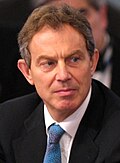Sandbox/UK/LA: Difference between revisions
Jump to navigation
Jump to search
(Created page with "{{Infobox election | election_name = 2005 United Kingdom general election | country = United Kingdom | type = parliamentary | ongoing = no | previous_election = 2001 United Kingdom general election | previous_year = 2001 | outgoing_members = List of MPs elected in the 2001 United Kingdom general election | elected_members = List of MPs elected in the 2005 United Kingdom general election | next_election = 2010 United Kingdom general election | next_year = 2010 | seats_for...") |
No edit summary |
||
| Line 1: | Line 1: | ||
{{Infobox election | {{Infobox election | ||
| election_name = | | election_name = 2003 United Kingdom general election | ||
| country = United Kingdom | | country = United Kingdom | ||
| type = parliamentary | | type = parliamentary | ||
| Line 8: | Line 8: | ||
| outgoing_members = List of MPs elected in the 2001 United Kingdom general election | | outgoing_members = List of MPs elected in the 2001 United Kingdom general election | ||
| elected_members = List of MPs elected in the 2005 United Kingdom general election | | elected_members = List of MPs elected in the 2005 United Kingdom general election | ||
| next_election = | | next_election = 2007 United Kingdom general election | ||
| next_year = | | next_year = 2007 | ||
| seats_for_election = All {{wp|List of United Kingdom Parliament constituencies (2005–2010)|646 seats}} to the {{wp|House of Commons of the United Kingdom|House of Commons}} | | seats_for_election = All {{wp|List of United Kingdom Parliament constituencies (2005–2010)|646 seats}} to the {{wp|House of Commons of the United Kingdom|House of Commons}} | ||
| majority_seats = 324{{refn|group=n|Given that Sinn Féin {{wp|members of Parliament}} (MPs) practise {{wp|abstentionism}} and do not take their seats, while the Speaker and deputies do not vote, the number of MPs needed for a majority was in practice slightly lower.<ref name=working>{{cite web |url=https://www.instituteforgovernment.org.uk/explainers/government-majority |title=Government majority |website=Institute for Government|date=20 December 2019 }}</ref> Sinn Féin won 5 seats, meaning a practical majority required 319 MPs.}} | | majority_seats = 324{{refn|group=n|Given that Sinn Féin {{wp|members of Parliament}} (MPs) practise {{wp|abstentionism}} and do not take their seats, while the Speaker and deputies do not vote, the number of MPs needed for a majority was in practice slightly lower.<ref name=working>{{cite web |url=https://www.instituteforgovernment.org.uk/explainers/government-majority |title=Government majority |website=Institute for Government|date=20 December 2019 }}</ref> Sinn Féin won 5 seats, meaning a practical majority required 319 MPs.}} | ||
| election_date = | | election_date = 20 November 2003 | ||
| registered = 44,245,939 | | registered = 44,245,939 | ||
| turnout = 27,148,510<br>61.4% ({{increase}}2.0 {{wp|Percentage point|pp}}) | | turnout = 27,148,510<br>61.4% ({{increase}}2.0 {{wp|Percentage point|pp}}) | ||
| opinion_polls = Opinion polling for the 2005 United Kingdom general election | | opinion_polls = Opinion polling for the 2005 United Kingdom general election | ||
<!-- Labour -->| image1 = {{CSS image crop|Image=Tony Blair | <!-- Labour -->| image1 = {{CSS image crop|Image=Tony Blair in 2002.jpg|bSize = 120|cWidth = 120|cHeight = 160|oTop = 0|oLeft = 0}} | ||
| leader1 = {{wp|Tony Blair}} | | leader1 = {{wp|Tony Blair}} | ||
| leader_since1 = {{wp|1994 Labour Party leadership election|21 July 1994}} | | leader_since1 = {{wp|1994 Labour Party leadership election|21 July 1994}} | ||
| Line 28: | Line 28: | ||
| percentage1 = '''35.2%''' | | percentage1 = '''35.2%''' | ||
| swing1 = {{decrease}} 5.5 {{wp|Percentage point|pp}} | | swing1 = {{decrease}} 5.5 {{wp|Percentage point|pp}} | ||
<!-- Conservative -->| image2 = {{CSS image crop|Image=Michael Howard (cropped).jpg|bSize = 120|cWidth = 120|cHeight = 160|oTop = 0|oLeft = 0}} | <!-- Conservative -->| image2 = {{CSS image crop|Image=Michael Howard (cropped).jpg|bSize = 120|cWidth = 120|cHeight = 160|oTop = 0|oLeft = 0}} | ||
| leader2 = {{wp|Michael Howard}} | | leader2 = {{wp|Michael Howard}} | ||
| Line 40: | Line 41: | ||
| percentage2 = 32.4% | | percentage2 = 32.4% | ||
| swing2 = {{increase}} 0.7 {{wp|Percentage point|pp}} | | swing2 = {{increase}} 0.7 {{wp|Percentage point|pp}} | ||
<!-- Liberal Democrats -->| image3 = {{CSS image crop|Image=Charles_Kennedy_MP_(cropped).jpg|bSize = 120|cWidth = 120|cHeight = 160|oTop = 0|oLeft = 0}} | <!-- Liberal Democrats -->| image3 = {{CSS image crop|Image=Charles_Kennedy_MP_(cropped).jpg|bSize = 120|cWidth = 120|cHeight = 160|oTop = 0|oLeft = 0}} | ||
| leader3 = {{wp|Charles Kennedy}} | | leader3 = {{wp|Charles Kennedy}} | ||
Revision as of 18:55, 27 December 2024
| |||||||||||||||||||||||||||||||||||||||||||||||||
All 646 seats to the House of Commons 324[n 1] seats needed for a majority | |||||||||||||||||||||||||||||||||||||||||||||||||
|---|---|---|---|---|---|---|---|---|---|---|---|---|---|---|---|---|---|---|---|---|---|---|---|---|---|---|---|---|---|---|---|---|---|---|---|---|---|---|---|---|---|---|---|---|---|---|---|---|---|
| Opinion polls | |||||||||||||||||||||||||||||||||||||||||||||||||
| Registered | 44,245,939 | ||||||||||||||||||||||||||||||||||||||||||||||||
| Turnout | 27,148,510 61.4% ( | ||||||||||||||||||||||||||||||||||||||||||||||||
| |||||||||||||||||||||||||||||||||||||||||||||||||
Colours denote the winning party, as shown in the main table of results. * Indicates boundary change – so this is a notional figure ‡ Figure does not include the Speaker, Michael Martin | |||||||||||||||||||||||||||||||||||||||||||||||||
Composition of the House of Commons after the election | |||||||||||||||||||||||||||||||||||||||||||||||||
| |||||||||||||||||||||||||||||||||||||||||||||||||
- ↑ "Government majority". Institute for Government. 20 December 2019.
Cite error: <ref> tags exist for a group named "n", but no corresponding <references group="n"/> tag was found


